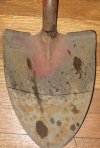Square_peg
Gold Member
- Joined
- Feb 1, 2012
- Messages
- 13,850
First, I'd just like to say how happy I am to find a place where there is a "Shovel discussion Thread".
Don't it feel good to be home?
The BladeForums.com 2024 Traditional Knife is available! Price is $250 ea (shipped within CONUS).
Order here: https://www.bladeforums.com/help/2024-traditional/
First, I'd just like to say how happy I am to find a place where there is a "Shovel discussion Thread".

This makes me ask; What do you guys consider a "GOOD" backpacking shovel?I of course would be interested (but can't afford) a custom backpacking shovel.
I've used those council tools some and am not a big fan. They're really heavy for what they are, the threads on the nut that lets you adjust the blade get clogged with dirt, and the bolt that holds the pieces together tends to loosen up under extended use. For that kind of work (trenching, scraping, etc) I'm really partial to what they call a rhino. You take one of those pointy FS shovels, cut it at the neck, cut off the pointy part, rotate the handle 180 around the long axis and weld it back on at a right angle to the blade... It's like that council tool when the blade is folded at a 90 except lighter and more elegant ergonomically, and able to move a lot more dirt. Will get photo.

It's a lot like a big hoe, only sturdier and you sharpen all three edges. For some reason the concave edge seems to be part of its advantage, though I can't really say why. Sorry about that attempted description. That is, remarkably, a tool I don't have just laying around. So this will have to do.
View attachment 271976
Cut where the 2 marker lines are (only try to make them straight) Throw away the pointy piece. Take the piece where the handle goes and orient such that the two parts you just separated are touching again, only with the handle coming toward you (it would be pointing pretty much straight out of the floor as oriented in this photo - it's hard to tell but it's sitting concave side up) and weld together. The angle between the handle and the head is best when it's just a bit under 90 degrees. Then give yourself some good edges. I prefer to sharpen mine on the outside though I've seen people use the existing inside profiles on the sides and then file the cut edge on the inside too. It's just hard to make a flat file put a good edge on a concave surface. Of course the handles on those shovels are on the short side, and I'm not, so I wind up stealing a piece of ash from some other tool and fitting it in there so I don't have to hunch over to use it. Against that collins folding tool, the flat edges are much better for cutting through brush and small tree limbs. Even that collins' flat edges don't really cut very well.

